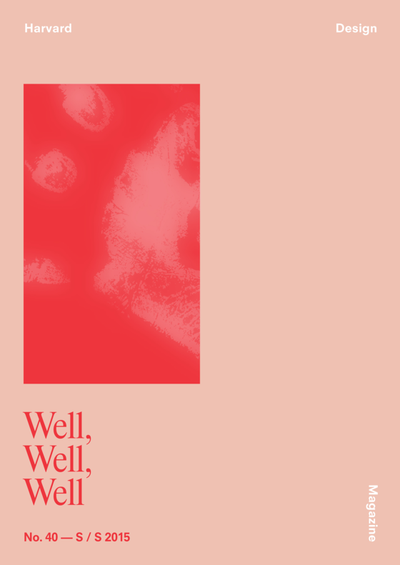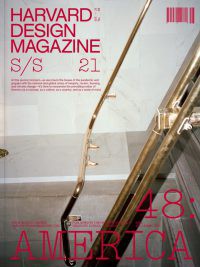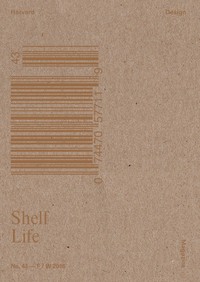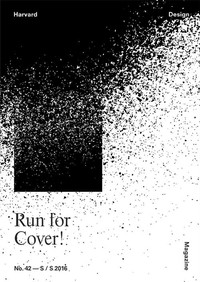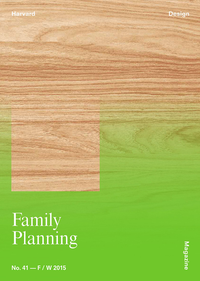Harvard Design Magazine i — Spring/Summer 2015, #40

Harvard Design Magazine
Relaunched in summer 2014, Harvard Design Magazine probes beyond the established design disciplines to enrich and diversify current discourse. Scholarly, poetic, and visually lush, each issue triggers new interpretations of design’s defining role in today’s culture. Distinguished and unexpected voices from the fields of architecture, landscape architecture, and urban planning meet those from the realms of art, science, literature, and beyond. A space for dialogue, speculation, and surprise: Harvard Design Magazine opens a door onto the applied device of design, and the people, places, and politics it engages.
- 404 (26)
- United States
- Two issues a year
- Art, Culture, Design
“Well, Well, Well”
Health, and the information around it, is messy. As are our bodies and the systems intended to help sustain them. No anatomical chart, in its immaculate precision, can articulate the ooze of our fluids and secretions, or our sensations of pain and fear; or the strain of accumulating medical bills; or the clash between the cult of wellness and rampant addiction; or the inequality of access to basic hygiene, nutrition, and medical care. Like health itself, our power—as individuals, citizens, and designers—to heal or to harm ourselves and the spaces in which we dwell is full of contradictions.
These contradictions are what generated this issue of Harvard Design Magazine. “Well, Well, Well” explores some of the tensions and transformations of the landscape of health and illness. As both designers and inhabitants, we create this landscape, and in turn, must navigate our own well-being within it. And as the rules of wellness continue to change—along with political events, science and technology, and nature itself—design and planning must adapt and respond accordingly. Architecture’s panaceas are not without expiration dates, and might even turn out to do more harm than good—but ultimately design has the power to promote and support health and healing in preemptive and progressive ways.
Table of Contents Editor’s Note
Checkup Jennifer Sigler Artifacts
Sculpo, Ergo Sum Jörg Scheller
Seeing the Forest for the Trees Julia Kane Africa, Yuko Tsunetsugu, Hui Wang
A Hygiene Hypothesis Hilary Sample
Delivering Scent, Designing Memory David Edwards
Everyone Needs Everything Nicholas Fox Weber
Flying Buttresses Matthew Allen
Healing the Machine Jeanne Gang
Holistic Planning Ann Forsyth
How Not to Die Jenna Sutela
In Your Backyard Jose Ahedo
Off-the-Grid Treatment Peter Rose
Reading Hollywood in the Smog David Gissen
Reanimator Susan Merriam
The End of Sitting RAAAF
Valerio’s Ark Peter Sealy
Youthfulness without Youth Deane Simpson Columns
Neuromancer Sport Claire L. Evans
White Coat Nancy Etcoff
Designing for Dignity Ai-Jen Poo
Healing Cuban-American Relations María Magdalena Campos-Pons
Out-of-Body Experiences: The Polis in Sickness and in Health Brooke Holmes
What Is Medicine? And Where? Charles E. Rosenberg Essays
Iatrogenic Architecture: Unreliable Narratives of Sustainability Kiel Moe
In Search of the Water Pump: Architecture and Cholera Michael Murphy
Messages from Material Reality Salmaan Craig
The Missing Link: Architecture and Waste Management Andreas Georgoulias, Hanif Kara, Leire Asensio Villoria
The Non-Spaces of Medical Tourism I. Glenn Cohen
A Medical-History Tour of Pretoria Sean O'Toole
Architecture that Breathes Annmarie Adams
Concrete Therapy: Paul Rudolph’s Architecture of Mental Health Mark Pasnik
Freedom by Design: The Paradoxes of Psychiatric Architecture Leslie Topp
Piss and the City Thomas A. P. Van Leeuwen
The Forgotten Birth of Parametric Design David Theodore
X-Ray Architecture: The Tuberculosis Effect Beatriz Colomina Interviews
Artificial Natures Matthew Allen, George Church
No More Shadows Barrett Brown-Fried, Aaron Betsky
On Atmosphere and Landscape Silvia Benedito, Germán del Sol
Urban Age Interboro Partners, Linda Fried Photo Essay
Silver Lining: The NORCs of New York Interboro Partners, Tim Davis Plus
Afflicted Form: A History of the Hospital MASS Design Group
What do you think of this issue?
Sign up or Log in to join the discussion.
Recent activity
- 18 May, 2016 Wanted by thomasbouillot
- 26 Nov, 2015 Added to pile by jennyblogger
- 20 Nov, 2015 New cover uploaded by Mottobooks
- 20 Nov, 2015 Added to Magpile by Mottobooks
